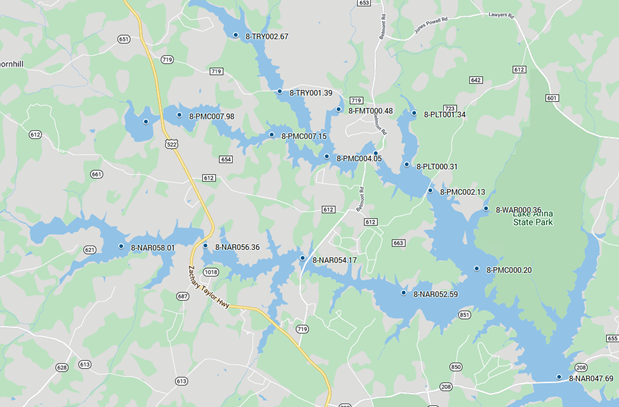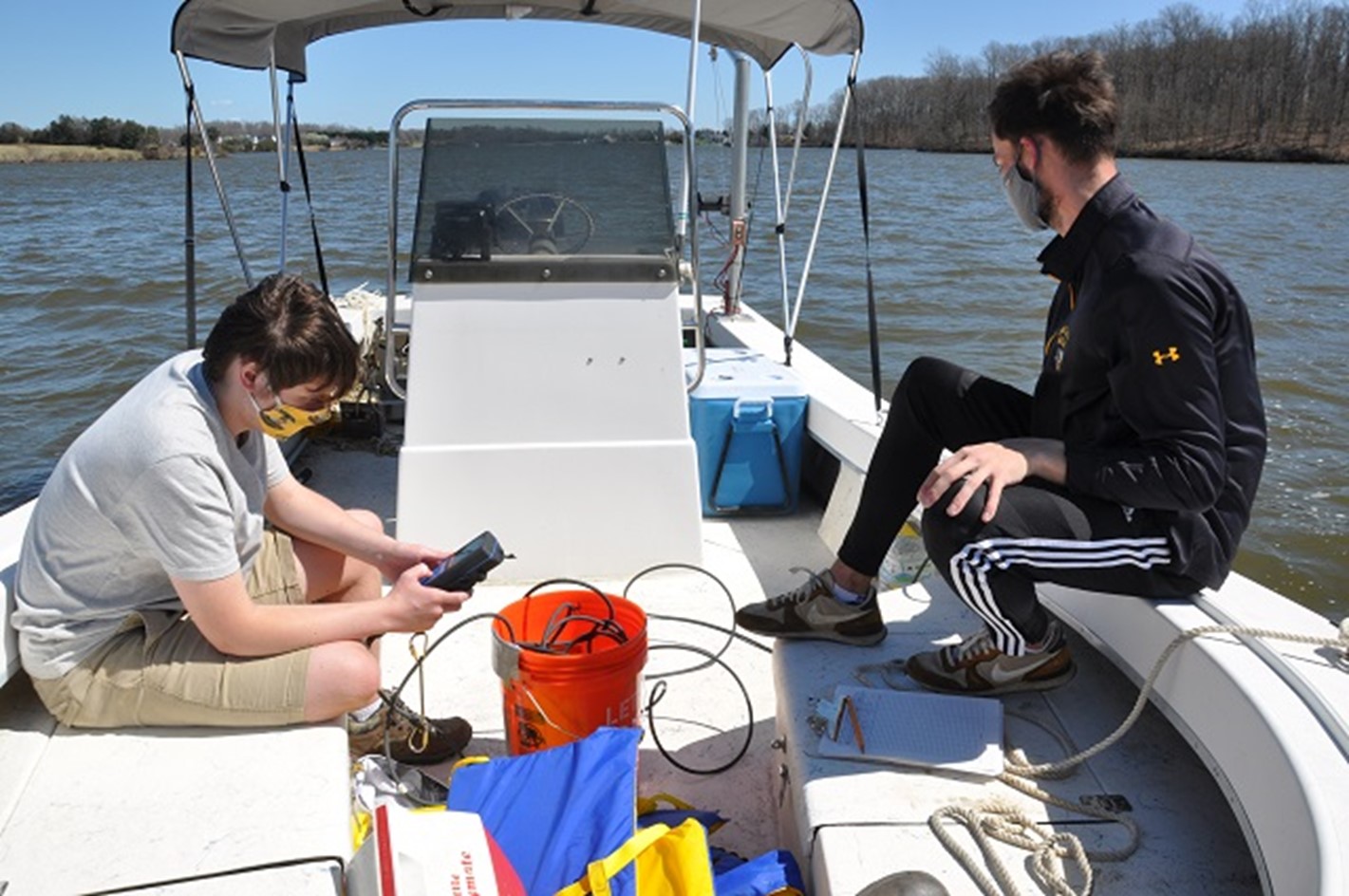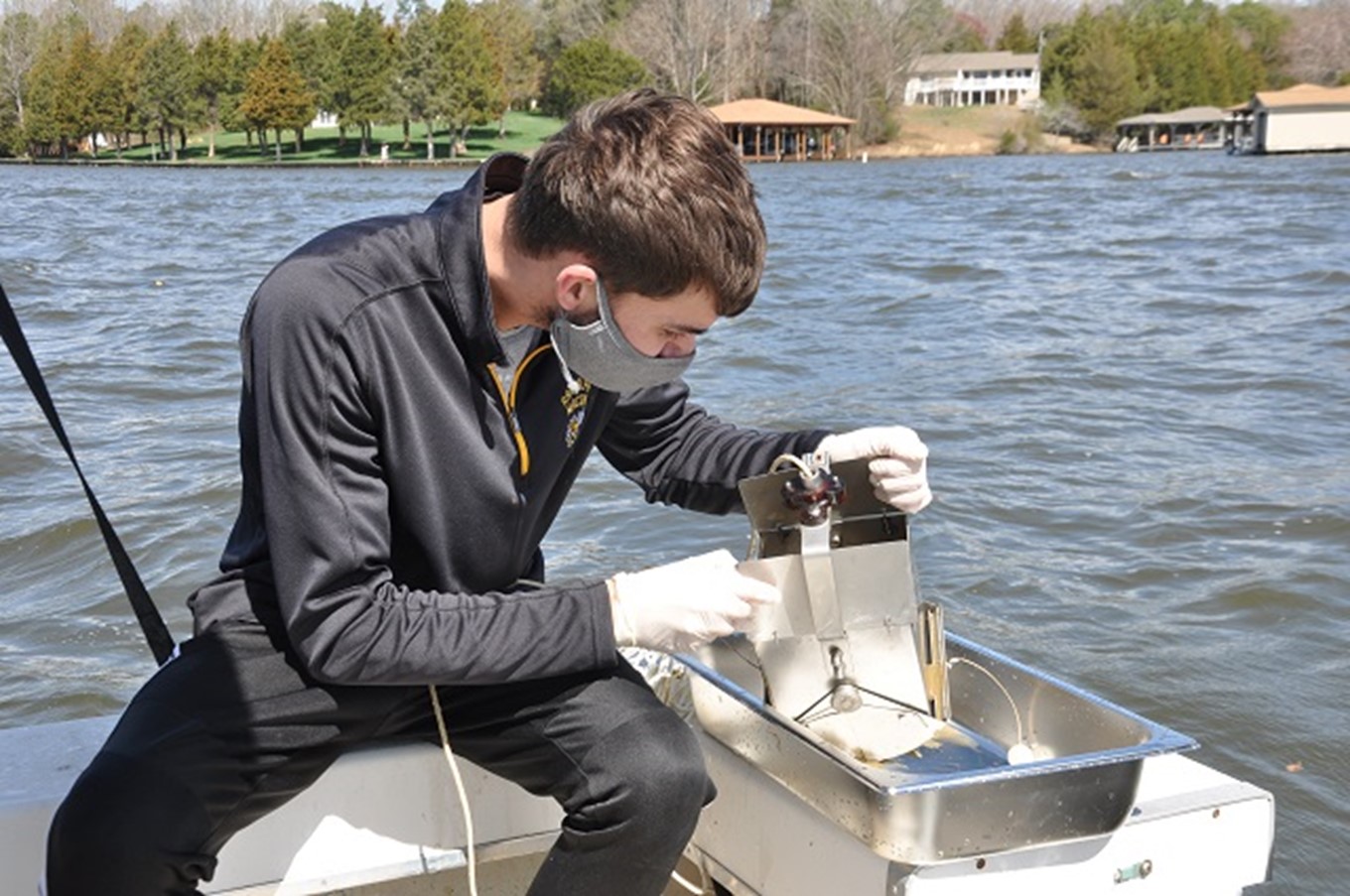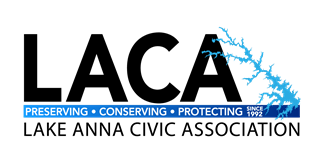By Harry Looney – July 2021
As we reported in an October 2020 newsletter article, LACA established an academic partnership with the Environmental Studies Program at Randolph-Macon College (R-MC) to investigate the impact of nutrients loads in the lake sediment on the lake’s algae problem. The project was executed over the entire academic year of 2020-2021 by two different Environmental Studies Program classes, one during the fall semester and the other during the spring semester. COVID-19, as might be expected, severely impacted the fall semester. R-MC’s COVID restrictions would not allow students to go out on boats with their instructor, so LACA and the Virginia Department of Environmental Quality (DEQ) implemented a back-up plan and were able to collect samples in September and then again in early November. The strong DEQ partnership with LACA on this project resulted in the allocation of two days of their manpower, boat, and laboratory resources as well as data from the extensive DEQ data base going back to the 1970s.
The R-MC research program was focused on sediment collection in the main tributaries from the 208 bridge to the northern headwaters of the lake (North Anna River, Pamunkey Creek and Terry’s Run). We included several creeks in the upper lake area as well (Plentiful Creek, Foremost Run and Ware’s Creek). 
This was the first time DEQ had ever sampled Lake Anna sediment for nutrients. There was a large sediment sampling effort back in the 2010-2012 timeframe, but those samples focused on contaminants such as PCBs and mercury.
The data from the September and November sampling campaigns were analyzed by students in the fall semester to quantify the levels of nitrogen, orthophosphates, and phosphorus in the sediment and in the water column at each sampling station. Given the COVID-19 constraints, LACA was extremely pleased with the fall semester results and an initial data set of sediment nutrient values was obtained.
The spring semester research effort started in February and students were able to come to the lake in March and April for sediment and water sampling activities. Laboratory parameters obtained during the fall and spring semester included phosphorous, orthophosphates and nitrogen in the lake sediment and in the water 1-meter from the bottom of the lake. Field parameters such as pH, temperature, and dissolved oxygen levels were also recorded at 1-meter intervals from the surface to the bottom at each sampling location.
While preliminary, the research conducted by R-MC provided LACA several insights on the issues confronting the upper lake regions due to algae. The students combined data analysis of the sediment and water sample results with an in-depth look at land use using a Geographic Information System (GIS) tool.  The students had access to 1-meter resolution GIS land use data layers including residential, agricultural, forested, and commercial land use areas. They also obtained data on septic systems approved in the Lake Anna area and biosolid permitted areas. The student teams then conducted statistical analysis using these GIS data layers, the data collected during eth research project, and historical data sets provided by DEQ and LACA to identify correlations in the data.
The students had access to 1-meter resolution GIS land use data layers including residential, agricultural, forested, and commercial land use areas. They also obtained data on septic systems approved in the Lake Anna area and biosolid permitted areas. The student teams then conducted statistical analysis using these GIS data layers, the data collected during eth research project, and historical data sets provided by DEQ and LACA to identify correlations in the data.  Six student teams were formed to focus on nitrogen, phosphorous, orthophosphates, pH, chlorophyll, and the ratio of Total Nitrogen to Total Phosphorous, a factor that has been shown in many other research papers to be an indicator of where algal blooms are likely to form.
Six student teams were formed to focus on nitrogen, phosphorous, orthophosphates, pH, chlorophyll, and the ratio of Total Nitrogen to Total Phosphorous, a factor that has been shown in many other research papers to be an indicator of where algal blooms are likely to form.
The significant correlations found during these team efforts provided several insights that require further analysis, but the data provides LACA with information we can use to initiate localized remediation efforts. The primary correlations identified by the students were lawns, crops, wetlands and forested areas. The data clearly showed, at a macro level, that areas where lawns and crops go down to the water’s edge correlate with higher levels of nutrients and areas with wetlands and forested areas tend to lower nutrient levels. The research provides the data and academic rigor to back up LACA’s suspicions that these land use factors are impacting our water quality. More surprising though was the finding that, at the macro level, septic systems and biosolids do not have strong correlations to areas where high nutrient loads exist in the sediment and water column. This was one research effort and the data was reviewed at a very macro level using datasets that go back 20 or more years in some cases.
LACA intends to continue to review the data and to take a more micro look at the data sets for areas experiencing aggressive algal issues. Sediment nutrient loading is one of the key knowledge gaps that LACA, LAAC and DEQ have identified with our understanding of the lake dynamics. The R-MC academic research effort addressed this knowledge gap and the data LACA received will ensure our decisions about future remediation efforts, and the resources expended to address the algal issues, are based on science informed by relevant, current data.
Results from the R-MC research project will be shared with the Lake Anna Advisory Committee (LAAC) that is executing a comprehensive study to determine the cause of our recent harmful algae blooms (HABs) and to inform course of action development into potential remediation actions that could be taken. Phase one of the LAAC project focuses on the North Anna River from Holladay Bridge west to the upper reaches of the lake. The objective of LAAC’s robust study is to determine the magnitude of phosphorus and nitrogen loading from external (from the streams) and internal (in the water column and sediment) sources.
Dr. Mike Fenster and Dr. Chas Gowan lead the R-MC research program. LACA nominated the R-MC professors for a York River and Small Coastal Basin Roundtable Excellence in Environmental Education award and both were selected as 2021 awardees. As part of the award, the Roundtable purchased a tree for each awardee and they were planted on the R-MC campus. An article on the award and the Environmental Studies Program at R-MC can be found at this link: https://www.rmc.edu/news-and-calendar/news-stories/2021/06/04/a-watershed-moment-for-r-mc-s-environmental-studies-professors
Interested LACA members are welcome to volunteer in support of LACA’s Water Quality Improvement program. Contact the Water Quality Project Officer at this link if you are interested in learning more or volunteering.
Harry Looney, LACA Water Quality Project Officer
harry.looney@lakeannavirginia.org
